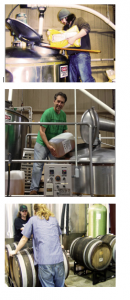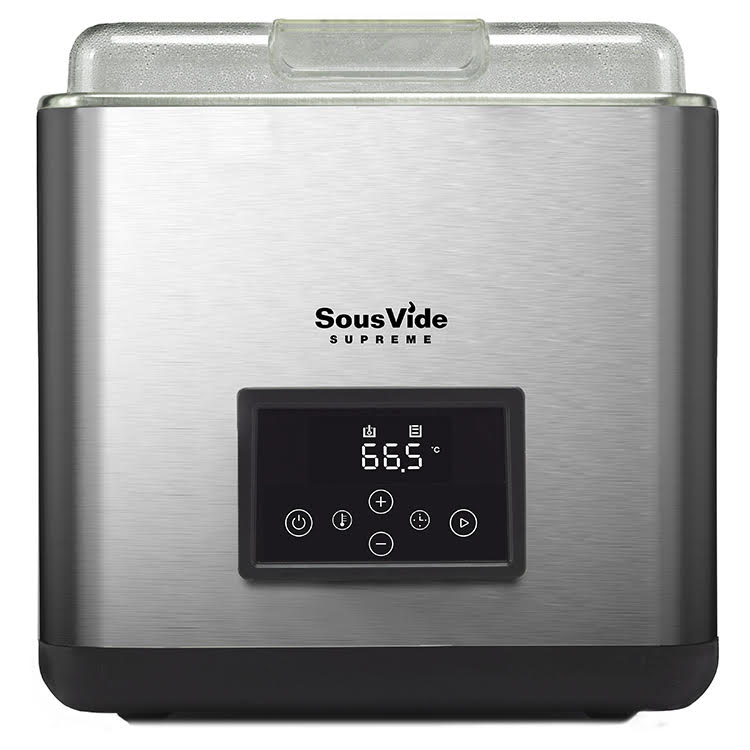We’re always on the lookout for novel and interesting ways to use our SousVide Supreme water ovens, so a recent article by Christopher Staten in Draft Magazine detailing a sous vide technique for making beer did not go unnoticed! Needless to say, we were maximally intrigued. So we reached out to the author, who kindly put us in touch with the man whose magic he’d chronicled, Karlos Knott, the head brewer at Bayou Teche Brewery. (Their Cajun brewery is situated on the family farm in Acadiana and was named by Southern Living magazine as the best brewery in Louisiana.)

In a happy bit of synchronicity, we learned Mr. Knott is a huge sous vide fan, who has had a couple of our SousVide Supreme water ovens for several years, using them almost daily for making yogurt, small test batches of new beer recipes, and cooking up Boudin and other Cajun delicacies.
At our request, he has very kindly provided us all with a pair of great, small batch sous-vide-cooked beer recipes: Sous Vide Biere, a traditional amber concoction, and a gluten-free version, called Sous Vide Pas La (Cajun French for ‘not there’). We’re going to let him tell you all about it – take it away Karlos!
Brewin’ up a Batch!
by Karlos Knott
Let me begin by saying that I love my Sous Vide Supreme water ovens and am honored to share this technique with all of you in the beer-loving, sous vide community. The water oven has really been a game changer in our family; we use it 7 days a week! But, let’s get on to beer.
Before we get started, let me stress that the main issue with beer brewing–and it can’t be emphasized enough–is everything has to be very clean, in fact, it MUST be sterilized. Most of a professional brewer’s career is spent cleaning equipment; just a few wild bacteria or yeast can ruin a whole batch of beer. With that caution, making sous vide beer is fun and very easy to do. These two recipes are real beginner recipes, and if any of you has a question or would like to know how to do the sous vide beers using whole grains instead of syrup (which would mean a bit more equipment, time, and cost) just comment here and I’ll be glad to help you out. So, let’s get you started.
EQUIPMENT you’ll need to gather
(available online at home brewing supplies stores)
- 2 large (1 gallon/3.8 liter) zip-closure cooking pouches
- 1 gallon (3.8 liter) fermenter jug with cap and airlock
- Large wire mesh strainer
- Funnel
- Auto siphon with hose
- Bottle filler
- 12 12-ounce bottles
- Bottle capper and caps
- Sanitizer solution
INGREDIENTS you’ll need on hand
(available online at home brewing supplies stores)
For Sous Vide Biere
- 1 1/2 pounds amber malt extract syrup*
- 7 g Cascade hop pellets*
- 3.5 grams Perle hop pellets*
- 0.5 ml Hopshot* (HopShot is CO2-extracted hop resin packaged in a syringe)
- 1/2 packet US-05 dried ale yeast*
- 12 Fizz Drop tablets*
For Sous Vide Pas La (gluten-Free beer)
- 1 ¼ pounds sorghum extract*
- 5 ounces honey
- 3 ounces dried rice extract*
- 1 ounce maltodextrin*
- 0.5 ml Hopshot (HopShot is CO2-extracted hop resin packaged in a syringe)*
- 1/4 ounce Citra hops*
- US-05 dried ale yeast*
- 12 Fizz Drop tablets*
Here’s what you’ll need to do…
Cook the wort
Mix together all the ingredients except the Fizz Drop tablets and yeast for whichever beer you’re making (for the Biere, that’s the malt extract syrup, hop pellets, and Hopshot and for the Pas La, it’s the sorghum extract, honey, dried rice extract, maltodextrin, hops and the Hopshot. (A note about the Hopshot: the amount you use can be modified, but be careful; it is pretty powerful stuff. However, if you like more bitter or hoppier beer feel free to add a bit more.) Divide the mixture evenly between two large (1 gallon/3.8 liter) zip-closure cooking pouches and add enough filtered water to each pouch to bring the total liquid up to 1/2 gallon (1.9 liters) and use the displacement method (Archimedes’ Principle) to evacuate the air and seal the pouches. Submerge the pouches in the Sous Vide water oven at 165F/73.5C for one hour. You are making what is called wort, or unfermented beer.
Sterilize the fermenting equipment
While the bag is in the water bath, sterilize the gallon fermenter jug, cap, airlock, funnel and wire mesh strainer per the Sanitizer instructions. You’ll place the funnel in the neck of the jug, with the strainer propped up in it.
Set up the fermentation
Remove the pouches and submerge them in a sink filled with cold water to cool the wort. Keep the pouches submerged in the sink until the wort gets to approximately 60–70F/15.5-20C — the pouches will be cool to the touch. Pour both pouches of the cooled wort through the strainer and funnel setup into the fermenting jug (do not fill past the one gallon mark on the jug). Use sanitized scissors to cut open the yeast pack and pour HALF of it into the wort in the jug. (Either discard the other half or use it soon for another purpose, such as bread making.) As to the choice of which yeast to use–there are many and each gives its own special character to the beer–I would start with the US-05. It is the cleanest and gives the best results for a beginners batch, but feel free to substitute another style of brewer’s yeast in the recipes….it would still turn out awesome. Just remember to let it ferment in a fairly cool and dark place, keep everything clean and sanitized and you can’t fail!
Seal the fermenter – fill the sanitized airock with approximately 1 tablespoon/15 ml of sanitizer solution, and fit the airlock into the hole in the screw cap. Move the fermenter to a dark, cool, quiet spot until fermentation is complete – about 2 weeks.
Wait
Two weeks after Brew Day, your beer is ready to bottle. Note: you’ll want a helper around for the filling step!
Sterilize the bottling equipment and bottle your beer
Get everything ready to bottle. Sanitize the auto-siphon’s hose, bottle filler, about a dozen each of 12-ounce bottles and bottle caps. Connect one end of the hose to the auto-siphon and the other end of the hose to the bottle filler. Remove the airlock and stopper from the jug and place the auto-siphon into the beer; while holding down the bottle filler to keep the valve open, have your helper pull up, then push down on the siphon piston to begin the flow of beer. Just lift up on the filler to stop the flow of beer. Try to leave about 1 inch (2.5 cm) of headspace in each bottle.
Add one Fizz Drop tablet to each bottle. This is a small charge of sugar and will carbonate the beer. To cap the bottles, put a sanitized bottle cap onto a filled bottle. Center the bell of your bottle capper on the cap and push down on the levers, then release. Put the now-filled bottles in a dark and cool spot for 10 days.
Wait some more…then try one out!
While you’re waiting for your beer to develop its character, treat yourself to a visit to a nearby independent brewery — you’ll especially enjoy it now that you know the care and passion that it takes to craft a beer. We encourage y’all to support your local brewers; these guys and gals work hard to bring a fine, locally-crafted product to your beer market as the little Davids among the Goliaths of the gigantic beer industry.
After 10 days, it’s time to test it out. Put one of your beers upright in the fridge and let it chill well. Pry off the cap and you should hear a nice pop and hiss (typical of the same sound as a commercially-brewed beer). Drink the beer! If not quite carbonated enough, allow the other bottles to stay at room temperature another week, then chill upright and enjoy.
One thing to note is you are brewing a bottle conditioned beer. There will be a small amount of yeast that settles on the bottom of the bottle during carbonation. This is natural. To enjoy, store your beers upright in the fridge and pour slowly out of the bottle into a glass, leaving behind the yeast sediment in the bottle.
Enjoy or as we say in Louisiana Santê!








 Easy Returns & Exchanges
Easy Returns & Exchanges Shipping Rates & Info
Shipping Rates & Info Satisfaction Guarantee
Satisfaction Guarantee Contact Us
Contact Us Email your questions to
Email your questions to 

4 Responses to Beer Making, Sous Vide Style